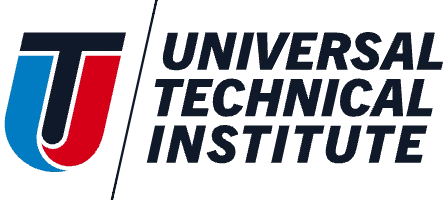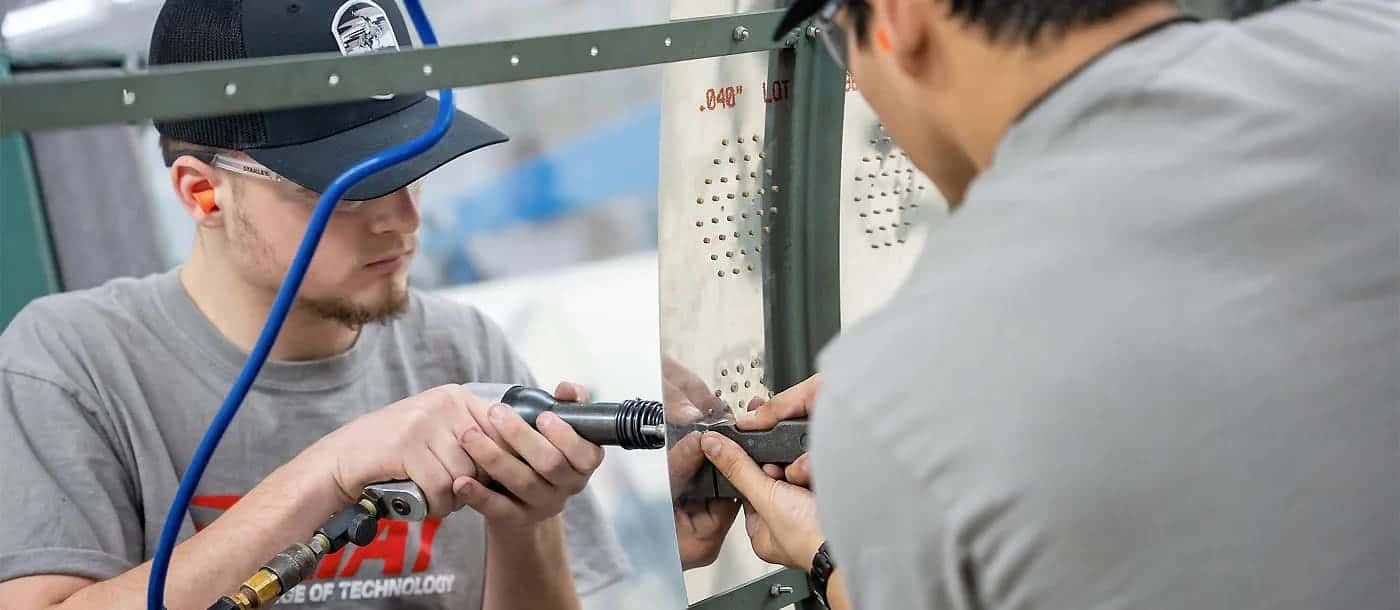Aviation mechanic courses at Universal Technical Institute (UTI) teach students the knowledge and skills needed to prepare to test for the Federal Aviation Administration (FAA) Airframe and Powerplant (A&P) certification and apply for entry-level aviation technician roles after graduation.79,128
Students can complete aircraft mechanic school in two years or less with hands-on training from instructors with real-world experience. Explore our aircraft mechanic courses to see how they prepare you for a career in aviation maintenance.
How To Enroll in Aviation Mechanic Courses Near Me
If you want to train for a career as an entry-level aircraft mechanic, first determine which of our programs you’d like to pursue.79 Our Airframe & Powerplant (A&P) Technician training program is available at our UTI campuses in Avondale, Arizona; Long Beach, California; Miramar, Florida; and Dallas and Houston, Texas.* UTI Canton, San Antonio and Atlanta offer an Aviation Maintenance Technology program in which graduates earn an associate degree!*
*Program coming to UTI Dallas, San Antonio and Atlanta pending FAA approval.
After you’ve chosen your preferred program, follow these steps:
- Get more information. Contact us online or call 800-834-7308 to learn about our programs and locations. An Admissions Representative can walk you through the enrollment process.
- Apply for financial support. If you’re interested in grants, scholarships or school loans you may qualify for to help pay for aircraft mechanic classes, our Financial Aid office can help.10 Call 844-338-0032, or email CentralizedFinancialAidAdvisors@uti.edu.
- Enroll and make moving arrangements. After you’ve applied, our Student Services team can assist students who need help securing housing near campus if you decide to move. Call 800-834-7308 for help.
Once you start school, it takes just two years or less to graduate, depending on the program and location. You can then apply and test for FAA certification, and upon earning this credential, you can begin applying for entry-level jobs in the aviation technician industry.
Why Take Aviation Mechanic Courses?
The aviation technician training options combine offers hands-on training designed to teach skills that meet industry demand. Students explore a wide range of airplane mechanic subjects, including hydraulics and pneumatics, turbine engine operation, non-destructive testing, airframe electrical systems, fuel systems and structural repair. Our courses teach in-depth knowledge and practical skills, preparing students to work on key aircraft systems using industry-relevant tools and techniques.
Aligned with FAA certification requirements, the program equips graduates with the skills needed to pursue certification. With experienced instructors and a focus on real-world training, aspiring aviation mechanics can develop a strong foundation so they can pursue careers in the field.79
Aircraft Mechanic Topic Overview
Our programs are designed to teach students the basics of air, airframe and powerplant science. You can learn skills in topics like turbine engine operation, powerplant lubrication systems, hydraulics and pneumatics, and aircraft troubleshooting. The following are some of the course topics to expect from the programs, although exact courses will vary by program.
Basic sheet metal and welding familiarization
Students receive a general introduction to the FAA’s requirements for sheet metal fabrication and repair. They can learn industry-standard practices for repair procedures, as well as fundamental operations like oxyacetylene equipment operation and safety.
Non-metallic structures
Students can learn about composite materials like Kevlar and fiberglass, which are used in aircraft construction. They can also learn about historical building techniques and materials, including fabric and wood.
Navigation and communication systems
Students can learn about aircraft communication, navigation, autopilot and approach control systems. This aircraft mechanic course also teaches students about FAA regulations, inspection, service and installation.
Hydraulics and pneumatics
In this airplane mechanic course, students can learn about basic hydraulic and pneumatic principles, operation and servicing of equipment. They are taught about component repair, covering fluids, seals, washers and pressures. Students can also participate in hands-on activities like inspecting hydraulic pumps for efficiency after a detailed disassembly and reassembly.
Powerplant lubrication systems
Students can discover how to identify lubricants and learn what their functions are. They can learn how to service and adjust the components, install lines and rings, interpret FAA regulations pertaining to oil tanks, and disassemble and reassemble engine oil pumps.
Turbine engine design
In this airplane mechanic course, students can develop an understanding of turbine engine design, including turboprop engines, turbofan engines and turbojet engines. They can learn about the multiple operating principles, as well as application benefits and the evolution of various designs.
Propellers
Students can learn about the theory of aircraft propellers, installation procedures, minor and major repair classifications, and aircraft applications of propellers and governors. They can learn how to inspect, check, repair and service propeller synchronization, how to balance propellers and how to install, remove and troubleshoot propellers.
These are just a few of the courses found in our aviation programs.
Next Steps After Aviation Technician Programs
Completing these airplane mechanic courses can help you build the knowledge and skills needed to test for FAA A&P certification. While enrolled, you can get hands-on with real machinery. Experienced instructors will teach the correct procedures and safety methods so you can build the technical knowledge needed to successfully complete the tasks of an entry-level aviation technician.
You can then apply for jobs that have requirements you meet. There are typically aviation technician jobs throughout the country. Connect with our Career Services team to find relevant opportunities where you want to work.
Prepare to test for aviation industry certification
Upon finishing the aviation technician training and passing all the aeronautical mechanic courses, graduates are prepared with the essential skills and knowledge to apply for the Airframe and Powerplant FAA certification exams, equipping them to tackle the challenges of real-world aviation maintenance and repair.79,128
Job search support for aviation graduates
We have a dedicated Career Services team to help graduates pursue entry-level roles. Advisors can connect students with potential employers and provide support with building resumes, preparing for interviews and developing job search skills.
AIRCRAFT MECHANIC COURSE FAQS
To be eligible for enrollment, you’ll need one of the following:
- Standards-based high school diploma that’s authorized by the state in which you graduate.
- State-issued GED certificate or state-authorized equivalent exam.23
- Successful completion of an officially recognized home-schooling program.
- Evidence of having previously attended a Title IV-eligible program or graduation from a degree program at the postsecondary level.
We have many students who enter our program with no prior aircraft knowledge or experience. As long as you’re willing to learn and dedicate effort to your aviation mechanic courses, you can succeed in the program.
Yes, UTI's aviation mechanic courses place a strong emphasis on hands-on training. Students practice directly with aircraft systems, tools and equipment to develop practical skills alongside classroom learning.
These courses typically cover aircraft structures, hydraulics, electrical systems, engines and avionics. Safety protocols, regulations and inspection procedures are also included to prepare students for certification and real-world maintenance work.1,79
Yes, many students work while enrolled, and Career Services can support this by connecting them with part-time industry opportunities.1 Our team can help students align their part-time jobs with training schedules to build experience that doesn’t interfere with their training.

